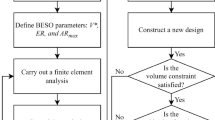Abstract
In a previous study, the authors presented a shape optimization scheme for continuum structures by a genetic algorithm and a boundary element method. In this paper, the study is extended to topology and shape optimization problems of the continuum structures.
Boundary profiles are expressed by spline functions. The chromosomes for the profiles are defined by a gene related to the topology (the number of internal boundaries) and genes related to the control points of the spline functions. The population is constructed by individuals with such chromosomes. The genetic opertors such as selection, crossover and mutation are applied to the population for searching the profile satisfying the design objectives. In the case of the objects with internal boundaries, intersection of the boundaries very often occurs and thus, the computational cost may become high. Therefore, we also discuss a scheme for increasing the computational efficiency in this case. Finally, the present scheme is applied to the topology and shape optimization of a plate in order to confirm its validity.
Similar content being viewed by others
References
Asayama, M.; Hasegawa, H.; Kawamo, K. 1996: Numerical experiments on size optimization of truss structures by use of genetic algorithm (in Japanese).Trans. JSME A62 1234–1241
Banerjee P.K.; Butterfield, R. 1981:Boundary element method in engineering science. McGraw-Hill
Bendsøe, M.P. 1988: Shape optimization as a discrete optimization problem—Solution procedure using continuous approximations. In: Eschenauer H.A.; Thierauf, G. (eds.):Discretization methods and structural optimization—Procedures and applications, pp. 40–47. Berlin, Heidelberg, New York: Springer
Bendsøe, M.P.; Kikuchi, N. 1988: Generating optimal topologies in structural design using a homogenization method.Comp. Meth. Appl. Mech. Eng. 71, 197–224
Brebbia, C.A. 1978:The boundary element fethod for engineers. Pentech Press
Chapman, C.D.; Saitou, K.; Jakiela, M.J. 1994: Genetic algorithms as an approach to configuration and topology design.J. Mech. Des. 116 1005–1012
Chen T.-Y.; Chen, C.-J. 1997: Improvements of simple genetic algorithm in structural design.Int. J. Num. Meth. Engrg. 40, 1323–1334
Davis, L. 1991:Handbook of genetic algorithms. Van Nostrand Reinhold
Deb, K. 1991: Optimal design of a welded beam via genetic algorithms.AIAA J. 29, 2013–2015
Galante, M. 1996: Genetic algorithms as an approach to optimize real-world trusses.Int. J. Num. Meth. Engrg. 39, 361–382
Goldberg, D.E. 1989:Genetic algorithms in search, optimization and machine learning. Reading, MA: Addison Wesley
Hasegawa, H.; Kawamo, K. 1995: A method for the shape and topology optimization of mechanical structures by using genetic algorithm (in Japanese).Trans. JSME A61, 183–190
Ihara, H.; Shimoda, M.; Azegami, H.; Sakurai, T. 1996: Weight reduction of automotive part using shape optimization technique considering topology (in Japanese).Proc. 79-rd JSME Spring Annual Meeting, Vol. 1, pp. 229–230
Jensen, E. 1992:Topological structural design using genetic algorithms. Ph.D. Thesis, Purdue University
Kirsch, U. 1989: Optimal topologies of structures.Appl. Mech. Rev., 42, 223–239
Kita, E.; Tanie, H. 1997a: Shape optimization of continuum structures by using genetic algorithm and boundary element method.Engineering Analysis with Boundary Elements: Special Issue, Optimization and Sensitivity Analysis with Boundary Elements
Kita, E.; Tanie, H. 1997b: Shape optimal design using GA and BEM. In: Hernandez, S.; Brebbia, C.A. (eds.)Computer aided optimum design of structures V (Proc. OPTI97, held in Rome), pp. 299–308
Le Riche, R.; Haftka, R.T. 1992: Optimization of laminate stacking sequence for buckling load maximization by genetic algorithm.Proc. 3-rd AIAA/ASME/ASCE/AHS/ASC Structures, Structural Dynamics and Materials Conf. (held in Dallas, TX), pp. 2564–2575
Le Riche, R.; Haftka, R.T. 1993: Optimization of laminate stacking sequence for buckling load maximization by genetic algorithm.AIAA J. 31, 951–956
Lin, C.-Y.; Hajela, P. 1993: Genetic search strategies in large scale optimization.Proc. 34-th AIAA/ASME/ASCE/AHS/ASC Structures, Structural Dynamics and Materials Conf. (held in Dallas, TX), pp. 2437–2447
Nagai, K.; Igarashi, M.; Gea, H.-C.; Kikuchi, N. 1995: Automotive applications of integrated structural optimization. In: Atluri, S.N.; Yagawa, G.; Cruse T.A. (eds.):Comp. Mech. '95, Proc. ICES95 (held in Hawaii, 1988), pp. 223–228. Berlin, Heidelberg, New York: Springer
Nagendra, S.: Haftka, R.T.; Gurdal, Z. 1993: Design of a blade stiffened composite panel by a genetic algorithm.Proc. 34-th AIAA/ASME/ASCE/AHS/ASC Structures, Structural Dynamics and Materials Conf. (held in La Jolla, CA), pp. 2418–2436
Ponslet, E.; Haftka, R.T.; Cudney, H.H. 1993: Optimal placement of tuning masses on truss structures by genetic algorithm.Proc. 34-th AIAA/ASME/ASCE/AHS/ASC Structures, Structural Dynamics and Materials Conf. (held in La Jolla, CA), pp. 2448–2457
Sakamoto, J.; Oda, J. 1993: A technique of optimal layout design for truss structures using genetic algorithm.Proc. 34-th AIAA/ASME/ASCE/AHS/ASC Structures, Structural Dynamics and Materials Conf. (held in La Jolla, CA), pp. 2402–2408
Sakurai, A.; Sugano, K.; Yoshimura, K.; Takayama, F. 1993:Spline functions by C language (in Japanese). Tokyo Denki University Press
Sandgren, E.; Jensen, E.; Welton, J. 1990: Topological design of structural components using genetic optimization methods. In:Sensitivity analysis and optimization with numerical methods, (Proc. Winter Annual Meeting ASME, held in Dallas, TX), pp. 31–43
Sandgren, E.; Jensen, E. 1992: Automotive structural design employing a genetic optimization algorithm.Proc. SAE Int. Cong. Exp. (held in Detroit. MI), SAE Technical Paper No.920772
Takahashi, K.; Takahashi, Y.; Watanabe, K. 1995: 2d shape optimization by genetic algorithms (in Japanese).Proc. 50-th Conf. of Information Processing Society of Japan, pp. 259–260
Tsuruta, Y.; Hasegawa, H.; Kawamo, K. 1997: A method for shape and topology optimization of mechanical structures using genetic algorithm (in Japanese).Trans. JSME.A63, 170–177
Watabe, H.; Okino, N. 1993: A study on genetic shape design. In: Forrest, S. (ed.):Proc. 5-th Int. Conf. on Genetic Algorithms, pp. 445–450. Morgan Kaufmann Publ.
Author information
Authors and Affiliations
Rights and permissions
About this article
Cite this article
Kita, E., Tanie, H. Topology and shape optimization of continuum structures using GA and BEM. Structural Optimization 17, 130–139 (1999). https://doi.org/10.1007/BF01195937
Received:
Revised:
Issue Date:
DOI: https://doi.org/10.1007/BF01195937




